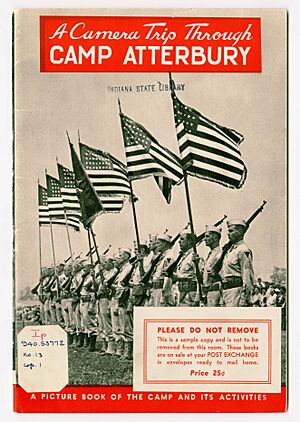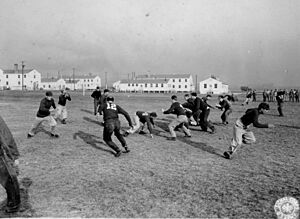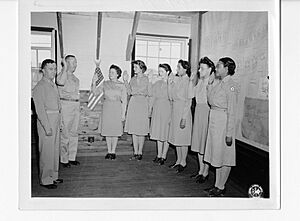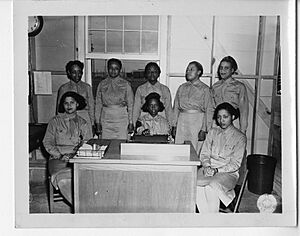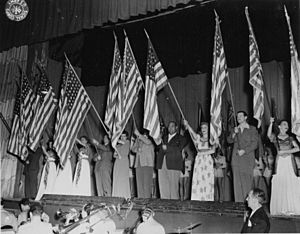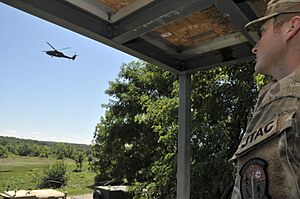Camp Atterbury-Muscatatuck facts for kids
Quick facts for kids Camp Atterbury-Muscatatuck |
|
|---|---|
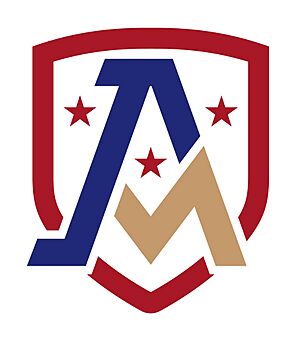
Camp Atterbury Joint Maneuver Training Center
|
|
| Type | Army and Air National Guard post |
| Site information | |
| Controlled by | United States |
| Site history | |
| Built | 1942 |
| In use | 1942–46, 1950–54, 1969–present |
| Garrison information | |
| Current commander |
COL James Babbitt |
| Country | United States |
| State | Indiana |
| Counties | Bartholomew, Johnson, Brown |
| Area | |
| • Total | 34,000 acre (14,000 ha) |
| Time zone | UTC−5 (Eastern (EST)) |
| ZIP code |
46124
|
| Area code(s) | 812 |
Camp Atterbury-Muscatatuck is a large military base in south-central Indiana, United States. It is owned by the U.S. government but run by the Indiana National Guard. The camp is located about 4 miles (6.4 km) west of Edinburgh, Indiana.
Its main job is to provide training and support for many soldiers at once. Camp Atterbury has different training areas, places for live shooting, and special airspace for air-to-ground practice. It also has a center for computer simulations and exercises. It's a key place for National Guard and Reserve forces in Indiana to do their yearly training.
Camp Atterbury was started in 1942. People sometimes call it "CAIN" or "The Rock." Its motto, Preparamus, means "We Are Ready."
Contents
- History of Camp Atterbury
- Choosing the Location and Building the Camp
- Camp Atterbury's Official Start
- World War II Facilities
- Wakeman General Hospital
- Commanders During World War II
- Units Trained During World War II
- Camp Newspapers and Radio
- Prisoner-of-War Camp
- Closing and Reopening
- Modern Camp Atterbury
- Muscatatuck Training Center
- 2008 Tornado
- Expansion and Future Plans
- 2021 Afghan Evacuees
- Support of Ukraine
- How Camp Atterbury Works Today
- Images for kids
- See also
History of Camp Atterbury
Choosing the Location and Building the Camp
In January 1941, the U.S. War Department started looking for a place to build a new U.S. Army training center in Indiana. They chose an area in south-central Indiana because it had both flat and hilly land. It was also close to big cities like Indianapolis and Columbus, and near important transportation routes like a railroad line and a highway.
On April 28, 1941, the U.S. War Department announced plans for a military camp that could hold 30,000 soldiers. After the attack on Pearl Harbor and the start of World War II for the U.S., they decided to go ahead with building Camp Atterbury on January 6, 1942.
To build the camp, the government bought over 40,000 acres (160 km²) of land. This land included farms, two small towns, fifteen cemeteries, and five schools. Most of the cemeteries were moved. Construction began in February 1942 and lasted about six months. At its busiest, nearly 14,500 workers were building the camp.
On February 6, 1942, the camp was named after Brigadier General William Wallace Atterbury. He was from New Albany, Indiana and was honored for his work in World War I. Because of heavy spring rains during its construction, the camp was sometimes nicknamed "Mudbury."
Camp Atterbury's Official Start
Camp Atterbury didn't have a big opening ceremony like most military bases. Soldiers started arriving for training just six months after construction began. The camp's official anniversary is August 15, 1942. This was the day the 83rd Infantry Division was officially formed there. About 25,000 people from Indiana came to watch the opening events.
Another important date for the camp is June 2, 1942. This is when the camp's very first official order was written.
World War II Facilities
Building Camp Atterbury cost about $35 million. It had many buildings for soldiers, officers, dining halls, and recreation. There were also places for water, sewer, and electricity, plus a railroad line. The camp had 21 firing ranges and a small fake town, called Tojoburg, for soldiers to practice fighting in a village setting.
At its largest, Camp Atterbury had 1,780 buildings. It could house over 44,000 officers and soldiers. This included barracks, mess halls, chapels, theaters, gyms, and swimming pools. It also had a large hospital.
Wakeman General Hospital
Camp Atterbury had a very modern hospital that started with 1,700 beds. It grew to become a 6,000-bed hospital and recovery center. In July 1942, a medical training school also opened there.
In April 1944, the hospital became a special hospital for treating soldiers wounded in combat. It was renamed Wakeman General Hospital. This was in honor of Colonel Frank B. Wakeman, a doctor who served in World War I.
In July 1944, the Women's Army Corps (WACs) Medical Department training school moved to Camp Atterbury. About 3,800 WACs were trained there in medical technology. Some stayed at Wakeman Hospital, while others went to other Army hospitals.
Wakeman General Hospital was one of the best-equipped hospitals in the U.S. during the 1940s. It was known for its plastic, nerve, and bone surgeries, and for making artificial eyes. By January 1945, it had 1,600 medical staff and 700 civilians helping 6,000 patients. The American Red Cross and local volunteers called Gray Ladies also helped patients.
By April 1945, Wakeman General and Convalescent Hospital could hold up to 10,000 patients. It treated about 85,000 patients during the war. The hospital closed at the end of 1946.
Commanders During World War II
Several military officers led Camp Atterbury during World War II. Colonel Welton M. Modisett was the first commander, starting in May 1942. Other commanders included Brigadier General Ernest A. Bixby and Colonels Herbert H. Glidden, John L. Gammett, and Carter A. McLennon. Colonel McLennon was the commander when the camp closed in December 1946.
Units Trained During World War II
From 1942 to 1944, four U.S. Army infantry divisions trained at Camp Atterbury before going overseas. These were the 30th, 83rd, 92nd, and 106th infantry divisions. Many other support units also trained there.
The 83rd Division was the first to arrive in August 1942. They even started a U.S. Army Ranger training school at the camp. The 92nd Division, which included African American servicemen, also trained there. The 30th "Old Hickory" Division and the 106th "Golden Lion" Division also prepared for combat at Camp Atterbury.
In 1943, the first Women's Army Auxiliary Corps (WAACs, later WACs) arrived at Camp Atterbury. They served in various roles. An all-black group of WACs arrived in May 1943 and worked at Wakeman Hospital, caring for wounded soldiers.
Camp Newspapers and Radio
Camp Atterbury had its own newspaper called The Atterbury Crier, which later became The Camp Crier. Wakeman Hospital also had its own publication called The Probe. These newspapers kept soldiers informed.
Wakeman Hospital even had its own radio station, WAKE. Camp Atterbury also had an all-soldiers radio show called "It's Time For Taps."
Prisoner-of-War Camp
From April 1943 to June 1946, a part of Camp Atterbury was used as a prisoner-of-war (POW) camp. It was surrounded by a double barbed-wire fence and guard towers. This camp held about 15,000 prisoners, mostly Italian and German soldiers. There were no escapes from the camp.
The POW camp was about 45 acres (0.18 km²) and could hold up to 3,000 prisoners. Wounded prisoners were treated at Wakeman Hospital. The prisoners worked as laborers around the camp and on nearby farms. They were paid for their work and had leisure time.
The first group of Italian prisoners arrived in April 1943. In 1943, the Italian prisoners built a small chapel called "The Chapel in the Meadow" using scrap materials. This chapel is still there today and has been restored. Former prisoners and their families sometimes return for reunions.
After the Italian prisoners left in May 1944, German prisoners began to arrive. By October, there were nearly 9,000 German prisoners at Camp Atterbury and smaller camps nearby. They also worked, mainly on farms and in canning factories.
Closing and Reopening
The U.S. Army stopped operations at Camp Atterbury in August 1946, and the camp officially closed in December 1946. However, the Indiana National Guard took over the site.
Camp Atterbury was reactivated in 1950 for the Korean War. The 28th Infantry Division and the 31st Infantry Division trained there. When the 31st Division left in 1954, Camp Atterbury was closed again.
Modern Camp Atterbury
Camp Atterbury remained quiet until the 1960s. In January 1969, the Indiana National Guard took full control. Since then, the camp has supported National Guard missions during conflicts like the Vietnam War, Operation Desert Shield, and the Gulf War.
The camp was originally over 40,000 acres (160 km²), but now it's about 30,000 acres (120 km²). Some land was leased for a state fish and wildlife area, a Job Corps center, and a park.
After the September 11, 2001 attacks, Camp Atterbury became even more important. It was activated as the Camp Atterbury Joint Maneuver Training Center (CAJMTC) in February 2003. Since then, thousands of soldiers have trained here before deploying to places like Afghanistan, Iraq, and Kosovo. It's one of only two National Guard bases with this important mission.
Muscatatuck Training Center
In July 2005, Camp Atterbury grew by about 1,000 acres (4.0 km²) when it acquired the Muscatatuck State Development Center. This former state mental facility was renamed Muscatatuck Urban Training Center (MUTC). It has 68 buildings, a reservoir, a submerged neighborhood, and tunnels. It was turned into a special training center for urban (city) warfare.
2008 Tornado
On June 3, 2008, a tornado hit Camp Atterbury, damaging about 40 buildings. Even with the damage, training continued for over 2,000 troops. Four days later, the National Guard and U.S. Marines from Camp Atterbury helped with the June 2008 Midwest floods.
Expansion and Future Plans
In April 2010, plans were announced to reclaim more land for new offices, barracks, and facilities for the Indiana National Guard. Camp Atterbury hopes to eventually return to its original 1942 size.
2021 Afghan Evacuees
After the War in Afghanistan (2001–2021) ended, Camp Atterbury became a temporary home for about 7,500 Afghan refugees. This was part of "Operation Allies Welcome." The first refugees arrived on September 1, 2021. They included American citizens, Afghans who helped the U.S. military, and other vulnerable Afghans. The last refugees left the camp by mid-2022.
Support of Ukraine
Following the Russian invasion of Ukraine in February 2022, Camp Atterbury helped prepare M113 armored vehicles and other equipment to be sent to Ukraine.
How Camp Atterbury Works Today
Camp Atterbury Joint Maneuver Training Center
Today, Camp Atterbury Joint Maneuver Training Center (CAJMTC) is a key training site for the Army National Guard, Active Army, Reserve, and other military forces. It helps units prepare for missions by offering advanced training.
The camp has about 26,000 acres (105 km²) for training, a 6,000-acre (24 km²) impact area for live firing, and urban training areas. It also has a 3,000-acre (12 km²) living area for soldiers. Camp Atterbury offers many training ranges, live-fire areas, and special airspace for air-to-ground training. It also has a center for computer simulations. The camp provides secure facilities, classrooms, and conference spaces for different training needs.
Regional Training Institute
The Indiana Regional Training Institute (RTI) at Camp Atterbury trains soldiers in combat arms skills. This includes teaching them new job skills and helping non-commissioned officers advance their careers. The RTI also runs a Warrant Officer Candidate School and an Officer Candidate School. It helps train civilians for future deployments too.
Joint Simulation Training Exercise Center
The Joint Simulation Training Exercise Center (JSTEC) is a large facility for big training exercises and simulations. It has eight buildings with about 80,000 square feet (7,400 m²) of indoor training space. The main building is used to control large simulation exercises. The other buildings can be set up for different unit training needs. This center can connect to training exercises around the world.
Atterbury Rail Deployment Center
The Atterbury Rail Deployment Facility (ARDF), also called the "railhead," is a vital part of the camp. It can load and unload a Brigade Combat Team (a large group of soldiers and equipment) onto trains in just 72 hours. It can handle 120 rail cars per day. This facility is very important for moving troops and equipment for missions.
Muscatatuck Urban Training Center
Muscatatuck (MuTC) is a unique training area that looks like a real city. It's the Department of Defense's largest and most realistic urban training facility. It helps train those who protect the homeland and work for peace.
MuTC has a physical city layout with over 190 buildings and 1.5 million square feet (140,000 m²) of space. It also has 1.8 miles (2.9 km) of underground tunnels, a cave system, and over nine miles (14 km) of roads. There's also a 185-acre (0.75 km²) reservoir and a special range for cyber training. This allows for training in land, air, sea, cyberspace, and space. Sometimes, actors are used as role-players to make the training even more realistic.
Indiana Air Range Complex
The Indiana Air Range Complex (IARC) is an area for training and testing with special airspace. It supports both kinetic (physical) and non-kinetic (electronic) air-to-ground operations. It includes Camp Atterbury, Muscatatuck Urban Training Center, and Jefferson Range. The IARC helps train for unmanned aerial systems (drones) and close-air support.
Images for kids
See also
 In Spanish: Camp Atterbury para niños
In Spanish: Camp Atterbury para niños




